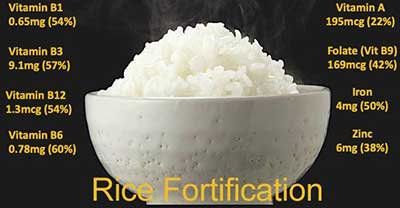Relevance: GS-2: Issues relating to development and management of Social Sector/Services relating to Health, Education, Human Resources, issues relating to poverty and hunger.
Relevance: GS-3: Public Distribution System
Key Phrases: Integrated Child Development Services, Pradhan Mantri Poshan Shakti Nirman-PM POSHAN, Aspirational and High Burden Districts, Food Safety and Standards Authority of India, Fortified Rice Kernels, Food Diversity, Balanced Diet
Why in News?
- Government of India has started the distribution of fortified rice through ration shops from April 1, 2022, in 90-odd districts out of 291 targeted for the entire year under phase II of PM-POSHAN Abhiyan for which it has procured 90 lakh tonnes (lt) of the grain.
Key Highlights:
- The government aims to distribute fortified rice through all central government schemes by 2024 to address the issue of malnutrition among the poor.
- The first phase was launched in October 2021 under which fortified rice
was supplied through
- Integrated Child Development Services (ICDS) and
- Pradhan Mantri Poshan Shakti Nirman-PM POSHAN (erstwhile Mid-Day Meal Scheme).
- Further, the government aims to cover 291 aspirational and high burden districts in the second phase for which the estimated grain requirement will be about 175 lakh tonne a year.
- About 2.20 lakh tonnes of such rice has already been supplied to 90 districts in 16 States during April-May, 2022.
What is rice fortification?
- The Food Safety and Standards Authority of India (FSSAI) defines fortification as deliberately increasing the content of essential micronutrients in a food to improve the nutritional quality of food and to provide public health benefits with minimal risk to health.
- Fortified rice is made as per the standards fixed by the food safety regulator FSSAI, which has prescribed blending rice with three micronutrients - Iron, Folic Acid and Vitamin B12.
- Fortified rice kernels resemble milled rice in appearance, taste, and texture which are blended with non-fortified rice at a ratio of 1:100. This could be a micronutrient-rich alternative which fits Indian diet preferences.
- Various technologies are available to add micronutrients to regular rice, such as coating, dusting, and extrusion.
- The extrusion involves the production of Fortified Rice Kernels (FRKs) from a mixture using an ‘extruder’ machine. It is considered to be the best technology for India.
Reasons for fortification of Rice
- India has very high levels of malnutrition among women and children. According to Government data, every second woman in the country is anaemic and every third child is stunted.
- Malnutrition costs India at least ₹77,000 crore annually in terms of lost productivity, illness and death.
- Fortification of food is considered to be one of the most suitable methods to combat malnutrition.
- Rice is one of India’s staple foods, consumed by about two-thirds of the population. Per capita rice consumption in India is 6.8 kg per month. Therefore, fortifying rice with micronutrients is a good option to supplement the diet of the poor.
- Fortifying rice makes it more nutritious by adding vitamins and minerals in the post - harvest phase, many of which are lost during the milling and polishing process.
- The micronutrient content in fortified rice is much higher than brown or parboiled rice.
- India has the highest mortality in the world due to bleeding during delivery. Rice fortification helps to offset this, and thus, food fortification is implemented in 140 countries.
- The country loses about 1 per cent of GDP (₹2.03 lakh crore) due to iron deficiency anaemia and one rupee spent on nutritional interventions in India could generate ₹34.1-Rs 38.6 in public economic returns.
How can a beneficiary distinguish between fortified rice and regular rice?
- Fortified rice will be packed in jute bags with the logo (‘+F’) and the line “Fortified with Iron, Folic Acid, and Vitamin B12”.
Food fortification - a bane or boon?
- The health experts claim that the chemical or synthetic fortification of rice with iron is ‘detrimental’ to health and is ‘wasteful’ and ‘ineffective’ as iron is not the only cause of anaemia.
- Haemoglobin is a complex molecule that requires protein and copper, and magnesium, vitamin C.
- The iron absorption in the Indian diet is a huge problem. It is just five per cent.
- We can improve absorption by adding animal protein with the diet and organ meat.
- It is futile to push iron into our bodies without all the additional support system that the body requires to manufacture haemoglobin.
- The actual solution is to improve diets and food diversity such as inclusion of nutritious vegetables, millets, animal protein, and dairy products in the diet.
- Odisha is to become the first Indian state to include millets, pulses, vegetables in midday meals and ration scheme. Local recipes, millet laddus, sprouted green gram, crop diversification, women empowerment will be the focus of the initiative.
Conclusion:
- Rice fortification, thus, may be considered as having the highest potential to fill the gap in current staple food fortification programs as it is the staple food of 65 percent of the Indian population and reaches the most vulnerable and poorer section with the highest uptake in the government safety net programmes.
- But, maintaining a diverse diet is hugely important to health and to nutrition.
- If we need iron, we also need protein and other micronutrients. Thus, the government needs to focus on measures for improving the food diversity of its poor population.
Source: The Hindu BL
Mains Question:
Q. The Government of India has started distribution of fortified rice through ration shops to tackle the menace of chronic anaemia and malnutrition. Critically evaluate the significance of the step taken by the Government. (250 words).








